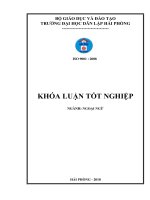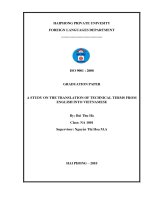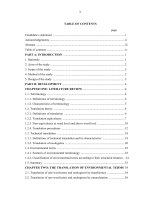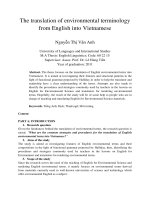A study on the translation of weather terms from English into Vietnamese
Bạn đang xem bản rút gọn của tài liệu. Xem và tải ngay bản đầy đủ của tài liệu tại đây (362.81 KB, 55 trang )
BỘ GIÁO DỤC VÀ ĐÀO TẠO
TRƯỜNG ĐẠI HỌC DÂN LẬP HẢI PHÒNG
-------------------------------
ISO 9001 : 2008
KHÓA LUẬN TỐT NGHIỆP
NGÀNH: NGOẠI NGỮ
HẢI PHÒNG - 2010
HAIPHONG PRIVATE UNIVESITY
FOREIGN LANGUAGES DEPARTMENT
-----------------------------------
GRADUATION PAPER
A STUDY ON THE TRANSLATION OF WEATHER
TERMS FROM ENGLISH INTO VIETNAMESE
By:
Đàm Thị Hồng Hạnh
Class:
Na1001
Supervisor:
Hoàng Thị Bảy, M.A
HAI PHONG - 2010
BỘ GIÁO DỤC VÀ ĐÀO TẠO
TRƯỜNG ĐẠI HỌC DÂN LẬP HẢI PHÒNG
--------------------------------------
Nhiệm vụ đề tài tốt nghiệp
Sinh viên:............................................................Mãsố:............................
Lớp:.............................Ngành:..................................................................
Tên đề tài: ................................................................................................
..............................................................................................
..............................................................................................
..............................................................................................
Nhiệm vụ đề tài
1. Nội dung và các yêu cầu cần giải quyết trong nhiệm vụ đề tài tốt
nghiệp
( về lý luận, thực tiễn, các số liệu cần tính toán và các bản vẽ).
……………………………………………………………………………..
……………………………………………………………………………..
……………………………………………………………………………..
……………………………………………………………………………..
……………………………………………………………………………..
……………………………………………………………………………..
……………………………………………………………………………..
……………………………………………………………………………..
2. Các số liệu cần thiết để thiết kế, tính toán.
……………………………………………………………………………..
……………………………………………………………………………..
……………………………………………………………………………..
……………………………………………………………………………..
……………………………………………………………………………..
……………………………………………………………………………..
……………………………………………………………………………..
……………………………………………………………………………..
……………………………………………………………………………..
3. Địa điểm thực tập tốt nghiệp.
……………………………………………………………………………..
……………………………………………………………………………..
……………………………………………………………………………..
CÁN BỘ HƯỚNG DẪN ĐỀ TÀI
Người hướng dẫn thứ nhất:
Họ và tên:.............................................................................................
Học hàm, học vị:...................................................................................
Cơ quan công tác:.................................................................................
Nội dung hướng dẫn:............................................................................
Người hướng dẫn thứ hai:
Họ và tên:.............................................................................................
Học hàm, học vị:...................................................................................
Cơ quan công tác:.................................................................................
Nội dung hướng dẫn:............................................................................
Đề tài tốt nghiệp được giao ngày 12 tháng 04 năm 2010
Yêu cầu phải hoàn thành xong trước ngày 10 tháng 07 năm 2010
Đã nhận nhiệm vụ ĐTTN
Đã giao nhiệm vụ ĐTTN
Người hướng dẫn
Sinh viên
Hải Phòng, ngày tháng năm 2010
HIỆU TRƯỞNG
GS.TS.NGƯT Trần Hữu Nghị
PHẦN NHẬN XÉT TÓM TẮT CỦA CÁN BỘ HƯỚNG DẪN
1. Tinh thần thái độ của sinh viên trong quá trình làm đề tài tốt
nghiệp:
……………………………………………………………………………..
……………………………………………………………………………..
……………………………………………………………………………..
……………………………………………………………………………..
……………………………………………………………………………..
……………………………………………………………………………..
……………………………………………………………………………..
……………………………………………………………………………..
2. Đánh giá chất lượng của khóa luận (so với nội dung yêu cầu đã đề ra
trong nhiệm vụ Đ.T. T.N trên các mặt lý luận, thực tiễn, tính toán số
liệu…):
……………………………………………………………………………..
……………………………………………………………………………..
……………………………………………………………………………..
……………………………………………………………………………..
……………………………………………………………………………..
……………………………………………………………………………..
……………………………………………………………………………..
……………………………………………………………………………..
……………………………………………………………………………..
3. Cho điểm của cán bộ hướng dẫn (ghi bằng cả số và chữ):
……………………………………………………………………………..
……………………………………………………………………………..
……………………………………………………………………………..
Hải Phòng, ngày ….. tháng ..… năm 2010
Cán bộ hướng dẫn
(họ tên và chữ ký)
NHẬN XÉT ĐÁNH GIÁ
CỦA NGƯỜI CHẤM PHẢN BIỆN ĐỀ TÀI TỐT NGHIỆP
1. Đánh giá chất lượng đề tài tốt nghiệp về các mặt thu thập và phân tích tài
liệu, số liệu ban đầu, giá trị lí luận và thực tiễn của đề tài.
2. Cho điểm của người chấm phản biện :
(Điểm ghi bằng số và chữ)
Ngày.......... tháng......... năm 2010
Người chấm phản biện
ACKNOWLEDGEMENTS
First of all, I would like to express my sincerity gratitude to Hai Phong
Private University where I have chance to study for 4 years.
I would like to extend my special gratitude to Ms Hoang Thi Bay (M.A) – my
supervisor who has generously given me valuable assistance and guidance
during the studying period and preparation of this graduation paper. The
success I got through last time would be almost impossible without her
enthusiastic supports.
My thanks also go to Ms Tran Thi Ngoc Lien (M.A), for her precious advice
and encouragement.
Finally, I thank for my family and friends who help me so much in studying
period.
TABLE OF CONTENTS
Acknowledgement
Part I: Introduction
1. Rationale .............................................................................................. 1
2.Aims of the research ............................................................................. 1
3. Scope of the research .......................................................................... 2
4. Method of the research ....................................................................... 2
5. Design of the research......................................................................... 2
Part II: Development
Chapter I: Theoretical background of translation
1. Definition of translation ...................................................................... 4
2. Kinds of translation ............................................................................. 6
2.1 Word to word ................................................................................ 6
2.2 Literal translation .......................................................................... 6
2.3 Faithful translation ........................................................................ 6
2.4 Semantic translation ...................................................................... 6
2.5 Free translation ............................................................................. 7
2.6 Adaptation ..................................................................................... 7
2.7 Idiomatic translation ..................................................................... 7
2.8 Communicative translation ........................................................... 7
3. Equivalences ........................................................................................ 7
4. ESP in translation ................................................................................. 9
4.1 Concept of ESP ............................................................................. 9
4.2 Type of ESP ................................................................................ 10
4.3 Weather ESP translation ............................................................. 11
4.4 Definition of technical translation .............................................. 12
4.5 Translation in area of weather terms ..........................................12
Chapter II: Terminology and English weather terms
1. Definition of English terms............................................................... 14
2. Characteristics of terms .................................................................... 15
2.1 Accurateness .............................................................................. 15
2.2 Systematism ................................................................................ 16
2.3 Internationalism .......................................................................... 16
2.4 Nationalism ................................................................................. 17
2.5 Popularity .................................................................................... 17
3. The creation of terminology ............................................................... 17
4. The distinction terms and words ........................................................ 18
5. English weather terms ........................................................................ 19
5.1 Definition of weather .................................................................. 19
5.2 Weather terms ............................................................................. 19
5.2.1 Weather description terms ................................................ 19
5.2.2 Weather phenomena terms................................................ 23
5.2.3 Meteorological terms ........................................................ 26
5.2.4 Abbreviation terms ........................................................... 27
Chapter III: Translation of English weather terms into Vietnamese
1. Some problems in translating English weather terms ...................... 29
1.1 Misunderstanding .................................................................. 29
1.2 Difficulties.............................................................................. 30
2. Some suggestions for the problems .................................................. 32
2.1 Some steps to translate .................................................................. 32
2.2 Some ways to translate English weather terms ............................. 33
2.2.1 Single terms ......................................................................... 33
2.2.2 Compound terms ................................................................. 35
2.2.3 Abbreviation terms .............................................................. 37
Part III: Conclusion .................................................................................. 40
Appendix ..................................................................................................... 42
Reference ..................................................................................................... 45
PART I: INTRODUCTION
1. Rationale
Nowadays,
English
is
the
dominant
international
language
in
communications, science, business, entertainment, diplomacy... In order to
know more about the world, we need to learn English. Translating English
weather terms is a good way to improve our English because it plays an
important role in distributing news and information. By the time, it may be an
entertainment activity.
Because language develops with society, being a good reader is a key to the
door of success. I always attract to English weather terms because of its lively
and its language features, so, this means that we should study it in order to
practice it, first at all, to understand it. Therefore, I conducted this research
with the hope that it could help learners have a deep knowledge of English
weather terms and could understand it.
2. Aims of the research
My research aims at:
- Introducing theoretical background of translation, terminology.
- Giving an analysis of English weather terms.
- Pointing out some difficulties, command mistakes possibly made by
Vietnamese learners and suggesting some solutions to avoid
misunderstanding when translating it.
3. Scope of the research
English weather terms are extremely large of the research. Due to the
limitation of time, knowledge, experience, I focus on feature of English
weather terms, give some problems when translating English weather terms
and give some strategies to apply to translate weather terms.
4. Method of the research
In order to achieve the mentioned aims, in my research process, I store
knowledge from a lot of different resources:
- Some websites, books about translation, terminology and English
weather terms to establish the theoretical background for my research.
- Collect and analyze some English weather terms.
- Give how to translate some English weather terms.
5. Design of the research
My paper is divided into 3 parts, the second one is the most important part.
Part I: The rationale, aims, methods, scope and design of the research are
mentioned in part one with the aim that the readers could have an overview of
my research.
Part II: Mentions the main content of the research and it is divided into 3
chapters:
Chapter I: Theoretical background of translation, English for specific purpose
(ESP)
Chapter II: Terminology, English weather terms and simply analysis;
including definition of term, weather, characteristics of weather terms
Chapter III: Some difficulties in translation process and some suggestions for
translating English weather terms
Part III: Part three summarizes main ideas mentioned in previous parts and
gives some suggestions for further research.
Part II: DEVELOPMENT
Chapter I: THEORETICAL BACKGROUND
1. Definition of translation
Translation has existed in every corner of our life. It is considered as an
indispensable part in the fields of not only literature, culture, but also
entertainment, scientific research, education… thus, definition of translation
is numerous and a large numbers of writers have written about this subject. In
this paper, some concepts of translation have been collected as follow:
Translation is the comprehension of the meaning of a text and the
subsequent production of an equivalent text, likewise called a
"translation," that communicates the same message in another
language. The text that is translated is called the source text, and the
language that it is translated into is called the target language. The
product is sometimes called the target text.
Translation, when practiced by relatively bilingual individuals but
especially when by persons with limited proficiency in one or both
languages, involves a risk of spilling-over of idioms and usages from
the source language into the target language. On the other hand, interlinguistic spillages have also served the useful purpose of importing
calques and loanwords from a source language into a target language
that had previously lacked a concept or a convenient expression for the
concept.
( />Translation is the process of changing something that is written or
spoken into another language.
(Advanced Oxford Dictionary)
Translation is a bilingual mediated process of communication which
ordinarily aims at the production of a TL text that is functionally
equivalent to a SL text.
(Reiss, 1971:161)
Translation is rendering the meaning of a text into another language in
the way that author intended the text.
(Newmark: 1988)
Translation is the expression in another language (target language) of
what has been expressed in one language (source language), preserving
semantic and stylistic equivalencies.
(By Roger T.Bell)
Translation is the interpretation of the meaning of a text in one
language (the source text) and the production in another language of
equivalent text (the target text) that communicates the same message.
(E.A Nida, 1959)
Translation is rendering a written text into another language in a way
that the author intended the text.
(By Bui Tien Bao- Ha Noi National University)
Translation, by dictionary definition, consists of changing from one
state or form to another, to turn into one’s own or another language.
(The Merriam-Webster Dictionary, 1974)
2. Type of translation
2.1 Word to word
This is often demonstrated as interline as translation, with the TL immediately
below the SL words. The SL word-order is preserved and the words translated
singly by their most common meaning, out of context.
2.2 Literal translation
The SL grammatical construction is converted to the nearest TL equivalent
but the lexical words are again translated singly, out of context.
2.3 Faithfull translation
The translation reproduces the exact contextual meaning of the original within
the constraints of the grammatical structure of the TL. It transfers cultural
words and preserves the degree of grammatical and lexical deviation from SL.
It attempts to be completely faithful to the intentions and the text reality of the
SL writer.
2.4 Semantic translation
It differs from faithful translation only in as far as it must take more account
of the aesthetic value of the SL text, compromising on “meaning” where
appropriate so that no assonance word-play or repetition jars in finished
version.
2.5 Free translation
This reproduces the matter without the manner, or the content without the
form of the original, but the translator just transmit meanings of the SL in
others expression. Usually, it is a paraphrase much longer than original.
Therefore, the text in TL sounds more natural but understands casually.
2.6 Adaptation
This seems to be the freest of translation. It’s used mainly for plays, poetry in
which the themes, characters and plots are usually preserved, the SL culture
converted to the TL culture and text rewritten.
2.7 Idiomatic translation
It reproduces the content of the original but tends to distort nuances of
meaning by preferring colloquialisms and idioms where these don’t exist in
the original.
2.8 Communicative translation
This attempts to reader the exact contextual meaning of the original in such a
way that both content and language are readily acceptable and
comprehensible to the readership.
3. Equivalences
Baker explores the notion of equivalence at different levels, in relation to the
translation process, including all different aspects of translation and hence
putting together the linguistic and the communicative approach. She
distinguishes:
Equivalence that can appear at word level and above word level when
translating from one language into another. Baker’s acknowledge that,
in a bottom-up approach to translation, equivalence at word level is the
first element to be taken into consideration by the translator. In fact,
when the translator starts analyzing the ST she looks at the word as
single units in order to find a direct equivalence term in the TL. Baker
gives a definition of the term word since it should be remembered that a
single word can sometimes be assigned different meaning in different
language, and might be regarded as being a more complex unit or
morpheme. This means that the translator should pay attention to a
number of factors when considering a single word, such as number,
gender, tense.
Grammatical equivalence when referring to the diversity of
grammatical categories across language. She notes that grammatical
rule may vary across language and this may pose some problems in
terms of finding a direct correspondence in the TL. In fact, she claims
that different grammatical structure in the SL and TL may cause
remarkable changes in the way information or message carried across.
The changes may induce the translator either to add or to omit
information in the TT because of the lack of particular grammatical
devices in the TL itself. Amongst these grammatical devices which
might cause problems in translation. Baker focuses on number, tense,
aspects, voice, person and gender.
Textual equivalence, when referring to the equivalence between SL text
and a TL text in terms of information and cohesion. Texture is a very
important feature in translation since it provides useful guidelines for
the comprehension and analysis of the ST which can help the translator
in his or her attempt to produce a cohesive and coherent text for the TC
audience in a specific context. It is up to the translator to decide
whether or not to maintain the cohesive ties as well as the coherence of
the SL text. His or her decision will be guided by 3 main factors that is,
the target audience, the purpose of translation and the text type.
Pragmatic equivalence, when referring to implicatures and strategies of
avoidance during the translation process. Implicatures is not about what
is explicitly said but what is implied. Therefore, the translator needs to
work out implied meanings in translator in order to get the ST message
across. The role of the translator is to create the author’s intention in
another culture in such away that enables the TC reader to understand it
clearly.
4. ESP in translation
4.1 Concept
ESP is the abbreviation for English for specific purpose. It is defined
in the other ways. Some people describe ESP as simply being the
teaching of English for any purpose that could be specified. Others,
however, were more precise describing it as the teaching of English
used in academic studies or teaching of English for vocational or
professional purpose.
Tony Dudley-Evans, co-editor of the ESP journal give an extended
definition of ESP in terms of “absolute and variable characteristics”
Absolute:
- ESP is defined to meet specific needs of the learners.
- ESP makes use of underlying methodology and activities of the
discipline it serves.
- ESP is centered on the language appropriate to the activities in terms of
grammar, lexis, register, study skill, discourse and genre.
Variable:
- ESP may be related to or designed for specific disciplines.
- ESP may use in specific teaching situation, a different methodology
from that of general English.
- ESP is likely to be designed for adult learners, either at tertiary level
institution or in professional work situation. It could, however, be for
learners at secondary school level.
- ESP is generally designed for intermediate or advanced student.
- Most ESP courses assume some basic knowledge of language systems.
4.2 Types of ESP
David Carter (1983) identified 3 types of ESP:
- English as a restricted language
- English for academic and occupational purposes
- English with specific topics
The language used by air traffic controllers or by waiters are example of
English restricted language. Mackay and Mountford (1987) clearly illustrate
the difference between restricted language and language with this statement
“… the language of international air-traffic control could be regarded as
“special”, in the sense that the repertoire required by the controller is strictly
limited and can be accurately determined situation, as might be the linguistic
needs of a dining-room waiter or air-hostess.
However, much restricted repertoires are not language, just as a tourist phrase
book is not grammar. Knowing a restricted “language” would not allow the
speaker to communicate effectively in novel situation, or in contexts outside
the vocational environment.
The second type of ESP identified by Carter (1983) is English for academic
and occupational purposes. In the “tree of ELT” (Hutchinson &Waters, 1987),
ESP is broken down into 3 branches:
- English for Science and Technology (EST)
- English for Business and Economic (EBE)
- English for Social Studies (ESS)
Each of the subject areas is further divided into 2 branches:
- English for Academic purpose (EAP)
- English for Occupational purposes (EOP)
And example of EOP for the EST branch is “English for technicians” whereas
an example of EAP for the EST branch is “English for medical studies”.
The third and final type of ESP identified by Cater (1983) is English with
special topics. Carter notes that it is only here where emphasis shifts from
purpose to topic. This type of ESP is uniquely concerned with anticipated
future English needs of, for example, scientists requiring English for post
graduate reading studies, attending conferences or working in foreign
institutions.
4.3 Weather ESP translation
Weather ESP translation is very important because most weather documents
are written in English language which needs to understand deeply. And it is
impossible to contrast a complete translation that captures the universal
meaning of the SL in the weather text without the full understanding about
weather terms which is an issue relevant to technical translation. Thus, this
part of the study is based on technical translation.
4.4 Definition of technical translation
Sofer (1991) as follow distinguishes technical translation from literal
translation “the main division in the translation field is between literary and
technical translation”. According to him, literal translation covers such areas
as fictions, poetry, drama and humanities in general and is done by writers of
the same kinds is the TL, or at least by translators with the required literary
attitude. Meanwhile, technical translation is done by much greater number of
practitioners and is an ever-going and expanding field with excellent
opportunities.
Newmark (1981) differently distinguishes technical translation from
institutional translation: “technical translation is one part of specialized
translation, institutional translation, the area of polities, commerce, finance,
government ...etc ...is the other”. He goes on suggesting that technical
translation is potentially non-cultural and universal because benefits of
technology are not confined to one speech community.
The terms in technical translation, therefore, should be translated. On the
contrary, institutional translation is cultural, so, in principle, the terms are
transferred unless they are connected with international organization. These
two authors, though having different approaches to technical translation they
both knew it as specialized translation with its essential element “specialized
terms”.
4.5 Translation in the area of weather terms
Weather is one of the popular specific fields, like other language, its
terminologies can change over time. If we translate in the weather field, we
must find the correct terminology used in the translation. Therefore, it would
be very helpful for our translation if we are constantly updating glossaries
related to the field as a whole, as well as specific weather topics. Besides,
translation of weather terms is quite complex, we are required translation
skills and domain knowledge to include the field of weather. Moreover, we
need to know more deeply about its word building, so the next- term in
weather field will show more in detail.
Chapter II: TERMINOLOGY AND ENGLISH
WEATHER TERMS
1. Definition
Up to now there are various definitions of terminology by many linguists.
In the Russian Encyclopedia (1976) terminology is defined as “a word
or a combination of words that denotes the concept precisely and its
relationship with other concepts in specific area. Terminology is a
specialized
and
restricted
expression
on
things,
phenomena,
characteristics, and the relationship in a specific profession”.
Terminology is a word or combination of words that is used in science,
technology, politics, art... and it has a specific meaning, denotes precise
concepts and names of the above-mentioned scientific areas.
(Nguyen Van Tu, 1960:176)
Terms are specialist words used within a scientific field, a professional
or any technological field.
(Do Huu Chau 1998)
Terminology is a section of special lexis of a language. It consists of
fixed words and groups of words which are accurate names of concepts
and subjects belonging to different specialized fields of human being.
(Nguyen Thien Giap, 1981)
Terms are words and compound words that are used in specific
contexts. Not to be confused with "terms" in colloquial usages, the
shortened form of technical terms (or terms of art) which are defined
within a discipline or specific field.
( )
2. Characteristics
As a special unit in the lexical system of language, terminology has its own
distinctive features. According to many linguists, terminology should have the
following qualities: accurateness, systematism, internationalism, nationalism,
popularity.
2.1 Accurateness
The first quality if terminology is accurateness, that is, it expresses a specific
concept or definition concretely and precisely so that it can help to avoid the
misunderstanding one concept for another. It is necessary for each term in a
typical professional scale, denotes only one concept in that system. The
meaning of a term is normally the combination of linguistic signals not only
the sum of its component’s meaning. Luu Van Lang (1977) claimed that each
linguistic signal poses one basic nuclear meaning and vice versa a concept
also has a typical linguistic signal in a concrete situation. New Mark (1998)
also said that concept-words are notorious for their different meanings in
various technologies. Therefore, when a term is created in a specific field, it is
necessary to take into account its homophone or synonymy which is often
seen in linguistics.
2.2 Systematism
It is the second criterion of a scientific term. As a part of a language, each
term has its own position in the system of concepts and belongs to a
terminological system. Each term requires its meaning in the relationship with









